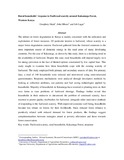| dc.description.abstract | The debate on forest degradation in Kenya is mainly concerned with the utilization and
exploitation of forest resources. Of particular interest is fuelwood, whose scarcity is a
major forest degradation concern. Fuelwood gathered from the forested commons is the
most important source of domestic energy in the rural areas of many developing
countries. For the case of Kakamega, as shown by this study, there is a declining trend in
the availability of fuelwood. Despite this state, rural households still depend largely on it
for energy provision in the face of limited options constrained by low capital base. This
study sought to examine how these households cope with the existing scarcity of
fuelwood. The study employed both primary and secondary sources of data. For primary
data, a total of 140 households were selected and interviewed using semi-structured
questionnaires. Response mechanisms were analyzed through descriptive methods by
looking at collection attributes, use patterns and fuel saving technologies applied by
households. Majority of households in Kakamega have resorted to planting trees on their
own farms to ease problems of fuelwood shortage. Findings further reveal that
households in their endeavor to circumvent the problem of continued scarcity, have
resorted to poorer quality tree/bushes for fuelwood, alongside other innovative methods
of responding to the fuelwood scarcity. With improved economic well being, households
become less reliant on forests for their livelihoods. Since reduced forest reliance is
positively related with reduced demand for forest products, the findings suggest
complementarities between strategies aimed at poverty alleviation and those towards
forest conservation. | en |

